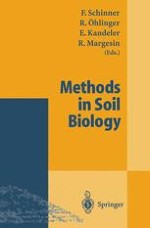1996 | OriginalPaper | Chapter
Community Structure of Soil Microorganisms
Author : L. Zelles
Published in: Methods in Soil Biology
Publisher: Springer Berlin Heidelberg
Included in: Professional Book Archive
Activate our intelligent search to find suitable subject content or patents.
Select sections of text to find matching patents with Artificial Intelligence. powered by
Select sections of text to find additional relevant content using AI-assisted search. powered by
The structural analyses of microorganisms in soil present a far more complex problem than their functional analyses (C02 determination, ATP measurement etc.). Microbial communities of soils are extremely diverse, and it is assumed that with conventional microbiological cultivation techniques only about 1% of the indigenous species are recovered (Torsvik et al. 1990). Therefore, methods that require neither growth nor removal of cells from the soil matrix are needed. Microbial diversity and community structure may be best estimated by RNA analysis (Ward et al. 1990) or DNA extraction (Torsvik et al. 1990). Besides these techniques, the extraction and analysis of the fatty acids derived from phospholipids (PLFAs) and lipopolysaccharides (LPS; Vestal and White 1989; Tunlid and White 1992) are a promising approach to classify the structure of the microbial communities in soils. The measurement of the content of the phospholipids has also been used to estimate microbial biomass in sediments and soils (Smith et al. 1986; Baath et al. 1992; Korner and Laczko 1992; Zelles et al. 1992; Frostegard et al. 1993; Hill et al. 1993).
